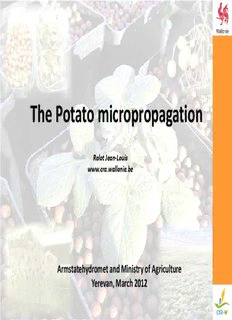
The Potato micropropagation PDF
Preview The Potato micropropagation
The Potato micropropagation Rolot Jean-Louis www.cra.wallonie.be Armstatehydromet and Ministry of Agriculture Yerevan, March 2012 Some characteristics of the potato multiplication Vegetative reproduction: ⇒Degeneration by infection of different pests (viruses, bacteria, fungi,…) ⇒ The propagation material needs to be regularly replaced: by injection at the top of the chain of very high quality material (free of diseases infections) How to replace the propagation material? ⇒ traditionally, by applying clonal and genealogical selection with, as departure point, some tubers that have been selected in field and checked in laboratory ⇒or, applying genealogical selection assisted by the in vitro micropropagation techniques: more easy, rapid, flexible and give more security for the phytosanitary quality. Example of traditionnal way for the production of seed potato material Initial material F0 1st year clones F1 2st year clones F2 3st year clones F3 F4, F5, F6, F7 Pre-basic seed lot (4 to 7 year) Basic seed lot (F8, F9, F10) S SE E Certified seed lot A B (F11, F12) Initial material: candidate tuber , indexed or not, sprout node excision and culturing Vitroplant (F0): from sprout node culture Vitroplant (F0): Has to be checked for diseases!!! maintained in in vitro collection and healthy Vitrotubers production (F0) b a In vitro multiplication e l h Genealogical n t I Selection assisted by in vitro e s u Micropropagation o h n e e r techniques g n I Minitubers production (F1) Vitroplants acclimatization OR and rooting (F0) Pre-basic seed (F1 to F3) Basic seeds S, SE, E (F4 to F6) d l e i F e h t n Certified seeds A, B (F7 to F8) I Advantages given by the genealogical selection assisted by the micropropagation techniques ⇒Saving of open field seeds generations = phytosanitary safety Classical genealogical selection In Vitro assisted genealogical selection F0 F1 F2 F3 F4 F5 F6 F1 F7 F2 F8 F3 S S SE SE E E A A B B Advantages given by the genealogical selection assisted by the micropropagation techniques ⇒ multiplication power = Production flexibility , rapid adaptation to the market opportunities In Vitro multiplication power r e 1000000 b m 100000 u 10000 n s 1000 t e 100 l t n 10 a l P 1 o n d j f m a ctob ovem écem anvie évrie ars vril r r r e b b r r e e Micropropagation techniques The in vitro introduction of a potato variety Micropropagation techniques • Potato variety in vitro introduction Main conditions: - the candidate tuber: to verify the variety - to get sprouts - to cut the sprouts, disinfect them with alcohol and cut them between nodes (=explant to be introduced in in vitro culture) - disinfection of the sprouts nodes = in Na hypochlorite, 5 à 8’ + and rising them in 3 successive bads of sterile H2O, 5’ – 10’ and 5’ - culture media = MS + Sugar (20g/l) + Agar (6g/l), pH 5,9 - culture conditions: 16h/8h , 18 to 22 C, 4000 to 6000 lux Micropropagation techniques Phytosanitary control scheme In collection Micropropagation techniques •Phytosanitary control operated when introducing potato explant in in vitro collection - Departure point: one or several tubers , each of them furnishing several sprout nodes: 1 node = 1 clone, then several clones / tuber, each of them having his own code (reference number) - Each clone (node) is introduced in vitro and multiplied separatly. Each clone will be fully tested. - After being tested, only one clone among the diseases free clones will be choosen and introduced in the in vitro collection. - A system of tracability must be operationnal in the micropropgation lab: each work and each analyse and results on the selected clone must be listed in a appropriate system of documentation.
Description: